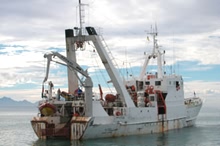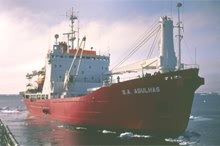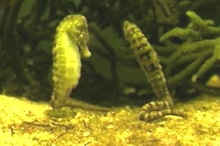SAEON now finds itself in deep waters
Dr Khotso Mokhele, President of the National Research Foundation (NRF), and Dr Monde Mayekiso, Deputy Director General of the Department of Environment and Tourism, and CEO of Marine and Coastal Management (MCM), signed an agreement for MCM to host a new SAEON Node for the marine-offshore ecosystems.
The initiative by SAEON to provide a home for all marine science data has been widely hailed by the marine science community as important and timely. A considerable body of knowledge exists within South African marine science, and much of this is reliant on historical and ongoing long-term observation programmes already stretching over many decades. However, a lot of data is in danger of being lost due to individuals leaving the system, or the data not having been digitised or not supported by adequate metadata.
Private consulting has also been a negative force on the promotion of free access to data. An additional complicating factor is the Marine Living Resources Fund (MLRF) which is funded by the fishing industry through levies, contributes significantly to the research of many organisations, and consequently bears perceived implications for intellectual property although this fund is administered by MCM.
On the positive side it has become evident that, whereas there has been a strong territoriality associated with data sets historically, even where data collection was performed with a public sector mandate, this might be slowly changing.
|
Why MCM?
One of the reasons why MCM was chosen to host the new SAEON Node for the marine-offshore ecosystems is that it has two vessels to do offshore research and monitoring, the Africana and the Sardinops. Both of these vessels are dedicated to marine research and spend more than 200 days at sea each year studying the state of our fish stocks. Research from these vessels informs decisions about the numbers of fish that may be allocated for commercial, recreational and subsistence fishing each year.
Offshore monitoring for fish stock assessment is the sole domain of MCM, because this relies on the availability of research vessels. The information is required to determine Total Allowable Catch per species on an annual basis. The MCM research vessels are also available for other research cruises from time to time, but the cost thereof is inherently high.
Other reasons for choosing MCM include the fact that it has a considerable body of existing long-term data, including fisheries data. SAEON's new node will add the necessary capacity to enable MCM to extract the full value of data in its possession.
MCM is moreover responsible for contract management of the South African Data Centre for Oceanography (SADCO), a repository for physical oceanographic data from ships cruising around southern Africa. SADCO collects the physical geographical and biological data and drives the Ocean Biodiversity Information System (OBIS). All this data is relevant to the node. SAEON has reached agreement with SADCO to collaborate with them and exchange data. This means that the SADCO data will be added to a central pool of environmental data that will be accessible through SAEON.
One of the key functions of SAEON according to its mandate is that the information and products stemming from research, monitoring and observation are made available in an easily accessible format to users worldwide. Data generation and data management will form a vital component of all SAEON's nodes.
SAEON Head Johan Pauw and his team are currently working with MCM to establish terms of reference for the node, and sort out the operational arrangements. The Node's staff will be appointed and employed by SAEON, unlike the staff of the other nodes who are employed by the host organisations. They will be housed with MCM in the Foretrust Building in Cape Town's foreshore area. An advertisement for a new node manager went out at the end of last month, for appointment in November.
SAEON and SADCO
With MCM being a partner in SADCO, also acting in a consultative capacity, these two bodies have been exchanging data for some time. With SAEON coming in, a more comprehensive arrangement will be required between all the bodies concerned. Through MCM, SAEON's interaction with SADCO will not only be in the form of a partnership, but will involve taking responsibility for the contract management of SADCO.
"Our role doesn't end there," says SAEON Head Johan Pauw. "We will make a financial contribution to SADCO on behalf of all South Africa's universities, which will allow them free access to the data. The universities are currently the biggest users of SADCO data." The physical oceanography data include salinity of the water, wave action, direction and strength of currents, and seawater temperature.
Exploring the southern ocean
SAEON's new node for the marine-offshore ecosystems extends well into the southern ocean.
"I think the oceans are getting increasingly important economically and scientifically," says Johan. "Obviously in aspects such as climate change we expect certain drastic changes to happen in the marine environment, changes that may have a far-reaching effect not only on the fishing industry, but also on the biodiversity of the oceans at large. Also important to note is the very distinct climatic/atmospheric link between the oceans and the African continent. What happens with the oceans around it will influence livelihoods on the continent. And much of it is not well researched. We need long-term data to clarify those links."
"So I think that no one could argue that the oceans are too far away from us to be important and that we should rather spend our available funds on terrestrial research. A considerable body of knowledge exists within South African marine science. Much of this is reliant on historical and ongoing long-term observation programmes already stretching over many decades."
For long-term fisheries research, MCM has been surveying certain fixed transects on an annual basis for a period of twelve years to monitor fish stocks, on the basis of which they then allocate the number of fishing permits. In this MCM fulfils a dual role: it has a regulatory function, but the information generated for that is of considerable value for research.
MCM also collates data from the fishing companies, who are under statutory obligation to provide the data to MCM. The fishing companies pay a levy towards MCM research, which entitles them to unrestricted access to that information. Research deals mostly with fish stocks – numbers caught, and in which locations. It will be useful for SAEON to tap into this information as well.
A constellation of core sites
SAEON's new node will be closely linked to the SAEON Elwandle Node, which will primarily be responsible for inshore monitoring. Gathering data from the coastal-inshore and marine offshore systems ought to present a holistic picture of how the marine environment is changing over time.
Recent advice by the SAEON Technical Steering Committee pointed to the prominent role that Node Managers would be required to play in assisting a bottom-up approach to the designation of core sites. The constellation of core observation sites must be derived from a broad consultative process driven by each node manager.
Discussions with organisations during the site visits pointed to some of the potential core and affiliated sites as being at Kosi Bay, Sodwana Bay, Aliwal Shoal, Algoa Bay, Tsitsikamma, De Hoop, Langebaan, St Helena Bay, and the proposed Groen-Spoeg Marine Protected Area.
The Sub-Antarctic Islands is a non-negotiable SAEON site, but managed independently of SAEON. As a result it is envisaged to be an affiliated site and data provider to the SAEON Node for marine-offshore ecosystems.
Synergies in education outreach
A Marine and Coastal Educators Network (MCEN) is another of SANCOR's coordinating groups. MCEN provides a network structure within which SAEON's marine and coastal nodes' education outreach programmes will find excellent support. The major organisations considered as potential host organisations all have an education section that could operate in synergy with SAEON.
Both nodes would be well-advised to include 'observer' or 'citizen science' programmes in their methodology, not only for the collection of data but also for the educational and outreach dimensions inherent to such programmes.
|













